John Deere D100 User Manual

John Deere Tractors
D100 Series
*OMGX24920* |
OPERATOR'S MANUAL |
|
|
|
John Deere Tractors |
|
D100 Series |
|
OMGX24920 ISSUE I3 (ENGLISH) |
CALIFORNIA
Proposition 65 Warning
Diesel engine exhaust and some of its constituents are known to the State of California to cause cancer, birth defects, and other reproductive harm.
If this product contains a gasoline engine:
 WARNING
WARNING
The engine exhaust from this product contains chemicals known to the State of California to cause cancer, birth defects or other reproductive harm.
The State of California requires the above two warnings. Additional Proposition 65 Warnings can be found in this manual.
John Deere Power Products
North American Edition
Printed in U.S.A.
*DCY*
*OMGX24920*

Introduction
Thank You for Purchasing a John Deere
Product
We appreciate having you as a customer and wish you many years of safe and satisfied use of your machine.
Using Your Operator’s Manual
This manual is an important part of your machine and should remain with the machine when you sell it.
Reading your operator’s manual will help you and others avoid personal injury or damage to the machine. Information given in this manual will provide the operator with the safest and most effective use of the machine. Knowing how to operate this machine safely and correctly will allow you to train others who may operate this machine.
If you have an attachment, use the safety and operating information in the attachment operator’s manual along with the machine operator’s manual to operate the attachment safely and correctly.
This manual and safety signs on your machine may also be available in other languages (see your authorized dealer to order).
Sections in your operator’s manual are placed in a specific order to help you understand all the safety messages and learn the controls so you can operate this machine safely. You can also use this manual to answer any specific operating or servicing questions. A convenient index located at the end of this book will help you to find needed information quickly.
The machine shown in this manual may differ slightly from your machine, but will be similar enough to help you understand our instructions.
RIGHT-HAND and LEFT-HAND sides are determined by facing in the direction the machine will travel when going forward. When you see a broken line (------), the item referred to is hidden from view.
Before delivering this machine, your dealer performed a predelivery inspection to ensure best performance.
Special Messages
Your manual contains special messages to bring attention to potential safety concerns, machine damage as well as helpful operating and servicing information. Please read all the information carefully to avoid injury and machine damage.
CAUTION: Avoid injury! This symbol and text highlight potential hazards or death to the operator or bystanders that may occur if the hazards or procedures are ignored.
IMPORTANT: Avoid damage! This text is used to tell the operator of actions or conditions that might result in damage to the machine.
NOTE: General information is given throughout the manual that may help the operator in the operation or service of the machine.
2
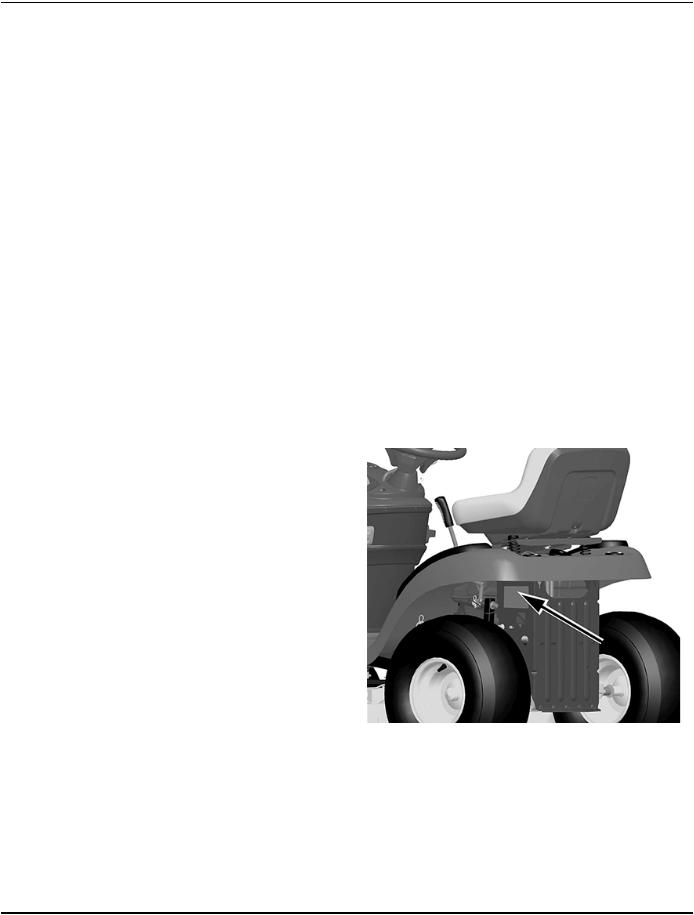
Contents
Contents
Introduction . . . . . . . . . . . . . . . . . . . . . . . . . . . . . . . . 2
Product Identification . . . . . . . . . . . . . . . . . . . . . . . . . 3
Safety Labels—Text . . . . . . . . . . . . . . . . . . . . . . . . . . 5
Safety Labels—No Text . . . . . . . . . . . . . . . . . . . . . . . 8
Safety . . . . . . . . . . . . . . . . . . . . . . . . . . . . . . . . . . . 10
Machine Cleanout . . . . . . . . . . . . . . . . . . . . . . . . . . 16
Assembly . . . . . . . . . . . . . . . . . . . . . . . . . . . . . . . . 18
Operating Controls. . . . . . . . . . . . . . . . . . . . . . . . . . 20
Operating . . . . . . . . . . . . . . . . . . . . . . . . . . . . . . . . 22
Service Intervals . . . . . . . . . . . . . . . . . . . . . . . . . . . 32
Service Lubrication . . . . . . . . . . . . . . . . . . . . . . . . . 33
Service Engine . . . . . . . . . . . . . . . . . . . . . . . . . . . . 34
Service Transmission. . . . . . . . . . . . . . . . . . . . . . . . 39
Service Mower. . . . . . . . . . . . . . . . . . . . . . . . . . . . . 39
Service Electrical. . . . . . . . . . . . . . . . . . . . . . . . . . . 44
Service Miscellaneous . . . . . . . . . . . . . . . . . . . . . . . 46
Troubleshooting. . . . . . . . . . . . . . . . . . . . . . . . . . . . 50
Storage. . . . . . . . . . . . . . . . . . . . . . . . . . . . . . . . . . 51
Specifications . . . . . . . . . . . . . . . . . . . . . . . . . . . . . 52
Warranty . . . . . . . . . . . . . . . . . . . . . . . . . . . . . . . . . 53
Getting Quality Service. . . . . . . . . . . . . . . . . . . . . . . 55
Service Record . . . . . . . . . . . . . . . . . . . . . . . . . . . . 57
Slope Gauge . . . . . . . . . . . . . . . . . . . . . . . . . . . . . . 58
Product Identification
Record Identification Numbers
Lawn Tractors
D105, D110, D125, D130, D140, D160, D170
PIN (E500001-) - 49 State, Australia
PIN (E050001-) - California
PIN (E200001-) - Canada, Mexico, ROW
If you need to contact an Authorized Service Center for information on servicing, always provide the product model and identification numbers.
You will need to locate the product identification number (PIN) for the machine and engine serial number. Record the information in the spaces provided below.
DATE OF PURCHASE:
_________________________________________
DEALER NAME:
_________________________________________
DEALER PHONE:
_________________________________________
PRODUCT IDENTIFICATION NUMBER:
__ __ __ __ __ __ __ __ __ __ __ __ __ __ __ __ __
ENGINE SERIAL NUMBER:
__ __ __ __ __ __ __ __ __ __ __ __ __ __ __ __ __
Machine Product Identification Number Location
Original Instructions. All information,illustrations and specifications in this manual are based on the latest information available at the time of publication.
The right is reserved to make changes at any time without notice.
COPYRIGHT © 2013
DEERE & COMPANY
Moline, Illinois
All rights reserved
A John Deere ILLUSTRUCTION © Manual
Previous Editions
Copyright © 2009, 2010, 2011
GXAL41941—UN—04MAR13
Located on left side of frame
3

Product Identification
Engine Serial Number Location
GXAL41942—UN—04MAR13
Single cylinder engines
GXAL41943—UN—04MAR13
V-Twin engines
Register Your Product and Warranty Online
To register your product through the Internet, simply go to www. JohnDeereWarrantyRegistration.com. Completing the information, either online or with the product warranty card, will ensure the customer that their product receives all post sales service and important product information.
4
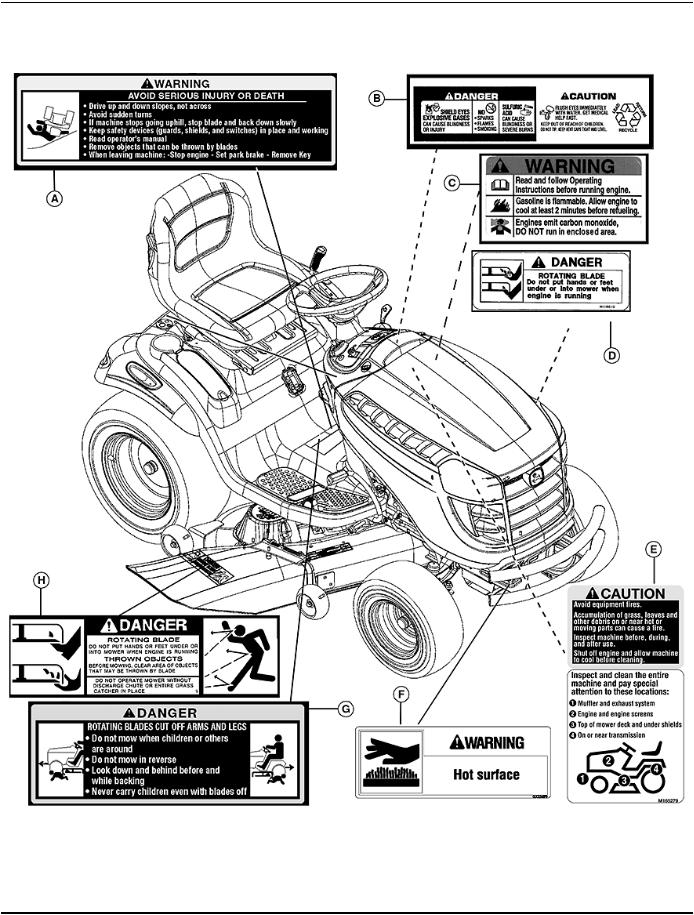
Safety Labels—Text
Safety Labels—Text
Safety Label Location (Text)
GXAL41944—UN—04MAR13
|
Use label number listed in table below to locate complete text of safety label message following this illustration. |
A — WARNING GX22477 |
E — CAUTION M165279 |
B — DANGER/CAUTION M128699 |
F — WARNING GX23479 |
C — WARNING MX4878 |
G — DANGER GX22477 |
D — DANGER M118610 |
H — DANGER M89504 |
5

Safety Labels—Text
Understanding The Machine Safety Labels
MXAL42363—UN—22MAY13
The machine safety labels shown in this section are placed in important areas on your machine to draw attention to potential safety hazards.
On your machine safety labels, the words DANGER, WARNING, and CAUTION are used with this safety-alert symbol. DANGER identifies the most serious hazards.
The operator’s manual also explains any potential safety hazards whenever necessary in special safety messages that are identified with the word, CAUTION, and the safety-alert symbol.
Replace missing or damaged safety signs. Use this operator’s manual for correct safety sign placement.
There can be additional safety information contained on part and components sourced from suppliers that is not reproduced in this operator’s manual.
Spanish Safety Signs and Operator’s Manual
Spanish versions of the operator’s manual and safety signs are available for this machine through authorized John Deere dealers. See your John Deere dealer.
NOTE: Both text and pictorial labels are shown below. Your machine will only be equipped with one of these types of labels.
Warning MX4878
GXAL41946—UN—04MAR13
•Read and follow Operating Instructions before running engine.
•Gasoline is flammable. Allow engine to cool at least 2 minutes before refueling.
•Engines emit carbon monoxide, DO NOT run in enclosed area.
DANGER
GXAL41947—UN—04MAR13
ROTATING BLADE
• Do not put hands or feet under or into mower when engine is running.
DANGER - M89504
GXAL41948—UN—04MAR13
ROTATING BLADE
• Do not put hands or feet under or into mower when engine is running.
THROWN OBJECTS
•Before mowing, clear area of objects that may be thrown by blade.
•Do not operate mower without discharge chute or entire grass catcher in place.
DANGER
GXAL41949—UN—04MAR13
ROTATING BLADES CUT OFF ARMS AND LEGS
•Do not mow when children or others are around.
•Do not mow in reverse.
•Look down and behind before and while backing.
•Never carry children even with blades off.
DANGER M128699
GXAL41950—UN—04MAR13
Located on battery
•Shield eyes, explosive gases can cause blindness or injury.
•No sparks, flames, smoking.
•Sulfuric acid can cause blindness or severe burns.
•Flush eyes immediately with water. Get medical help fast.
•Keep out of reach of children.
•Do not tip.
•Keep vent caps tight and level.
6
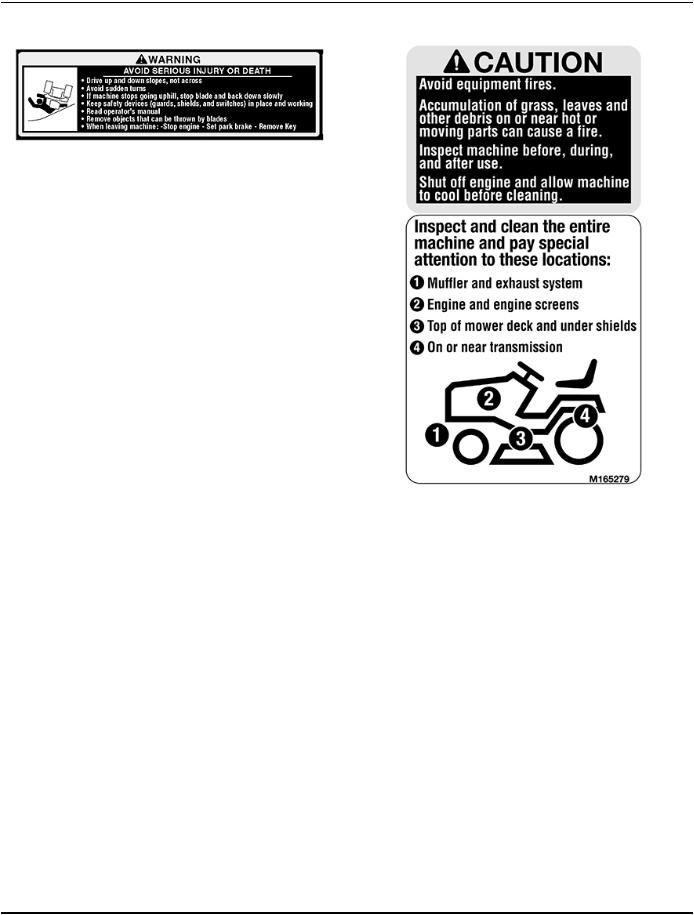
Safety Labels—Text
WARNING |
Prevent Equipment Fires |
GXAL41951—UN—04MAR13
AVOID SERIOUS INJURY OR DEATH
•Drive up and down slopes, not across.
•Avoid sudden turns.
•If machine stops going uphill, stop blades and back down slowly.
•Keep safety devices (guards, shields, and switches) in place and working.
•Remove objects that could be thrown by blades.
•Read operator’s manual.
•Remove objects that can be thrown by blades
•When leaving machine:
-Stop engine
-Set park brake
-Remove key
Avoid Injury From Hot Surface
WARNING
• Hot surface
GXAL41954—UN—04MAR13
GXAL41952—UN—04MAR13 • Avoid equipment fires.
•Accumulation of grass, leaves and other debris on or near hot or moving parts can cause a fire.
•Inspect machine before, during, and after use.
•Shut off engine and allow machine to cool before cleaning.
Inspect and clean the entire machine and pay special attention to these locations:
1.Muffler and exhaust system
2.Engine and engine screens
3.Top of mower deck and under shields
4.On or near transmission
Certification
Your mower has been certified for compliance with American National Standards Institute B-71.1-2003, “Safety Specifications” for Power Lawn Mowers, Lawn and Garden Tractors, and Lawn Tractors.
Canadian Electromagnetic Compatibility
(EMC) Compliance
This spark ignition system complies with Canadian ICES-002.
7
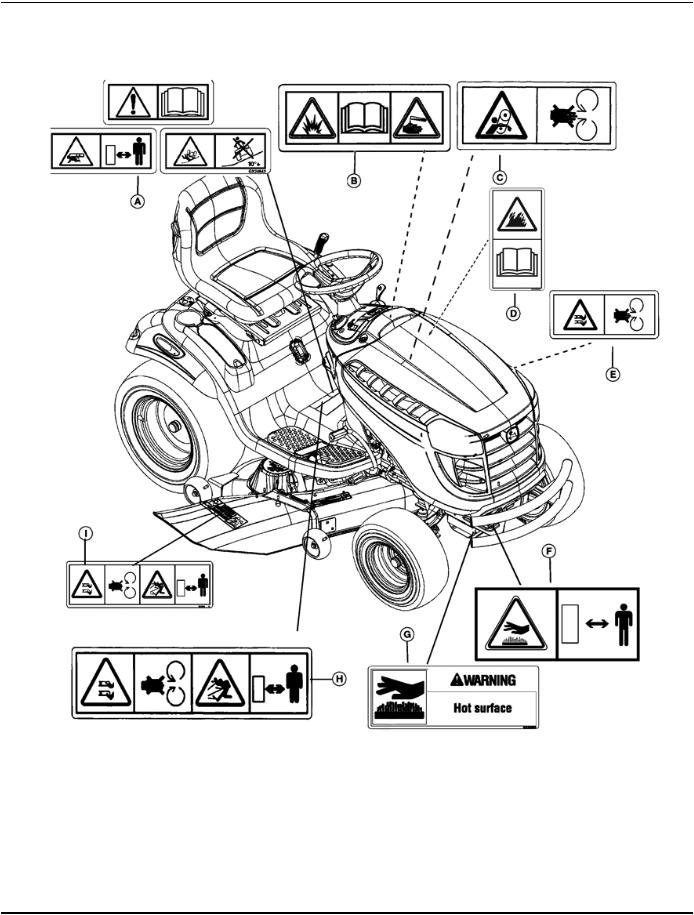
Safety Labels—No Text
Safety Labels—No Text
Safety Label Location (No Text)
PY19054—UN—16AUG13
Non-text labels are required for certain regions of the world. Your machine may not be equipped with these labels. Use label number listed in table below to locate complete text of safety label message following this illustration.
A — WARNING GX24842 B — WARNING M128484 C — WARNING M136436 D — WARNING GX24503 E — DANGER M118041
F— WARNING GX21121
G— WARNING GX23479
H— DANGER M148522
I— DANGER M118040
8

Safety Labels—No Text
Understanding The No-Text Machine Safety
Labels
TCT005498—UN—11SEP12
At several important places on this machine safety signs are affixed intended to signify potential danger. The hazard is identified by a pictorial in a warning triangle. An adjacent pictorial provides information how to avoid personal injury. These safety signs, their placement on the machine and a brief explanatory text are shown in this Safety section.
There can be additional safety information contained on parts and components sourced from suppliers that is not reproduced in this operator’s manual.
Read Operator’s Manual
MXAL42776—UN—09APR13
•This operator’s manual contains important information necessary for safe machine operation.
•Carefully read operator’s manual before operating machine. Observe all safety rules to avoid accidents.
Avoid Injury From Tipping
MXAL42779—UN—09APR13
•Do not drive where machine could slip, tip, or rollover.
•In some configurations, do not drive or operate on a slope of more than 10 degrees.
•Refer to the Operating on Slopes section for more information.
Avoid Injury From Thrown Objects
MXAL42780—UN—09APR13
•Keep a safe distance from the machine as long as the engine is running.
Keep Children Away from Mower |
Avoid Injury From Getting Caught in Belts |
MXAL42778—UN—09APR13
•Mower can cause dismemberment or death.
•Stay a safe distance from the machine.
•Make sure that children stay clear of mower at all times when the engine is running.
M136436—UN—24MAY13
•Stay clear of moving belts.
•Do not operate machine without shields in place.
9

Safety
Prevent Equipment Fires |
Avoid Injury From Hot Surfaces |
GXAL41960—UN—04MAR13
• Keep away from hot surfaces.
Safety
Operating Safely
PY19036—UN—07AUG13
Clean and inspect the entire machine.
Carefully read Operator’s Manual Machine Cleanout section for details.
Avoid Injury From Rotating Blades
MXAL42784—UN—09APR13
•Do not put hands or feet under or into mower when engine is running.
•Do not operate mower without discharge chute or entire grass catcher in place.
Avoid Injury From Battery Gases and Acid
MXT007302—UN—23MAY13
•Shield eyes, explosive gases can cause blindness or injury.
•No sparks, flames, smoking.
•Sulfuric acid can cause blindness or severe burns.
•Keep out of the reach of children.
•Do not tip.
•Keep vent caps tight and level.
•Flush eyes immediately with water. Get medical help fast.
GXAL42347—UN—04MAR13
This cutting machine is capable of amputating hands and feet and throwing objects. Failure to observe the following safety instructions could result in serious injury or death.
•Read, understand and follow all instructions on the machine and in manuals provided, and view safety video, before starting. Be thoroughly familiar with the controls and the proper use of the machine before starting.
•Do not put hands or feet near rotating parts or under the machine. Keep clear of the discharge opening at all times.
•Only allow responsible adults, who are familiar with the instructions, to operate this machine. Local regulations may restrict the age of the operator.
•Clear the area of objects such as rocks, wire and toys which could be thrown by the blades.
•Be sure the area is clear of bystanders before operating. Stop machine if anyone enters the area.
•Never carry passengers.
•Do not mow in reverse unless absolutely necessary. Always look down and behind before and while backing.
•Never direct discharged material toward anyone. Avoid discharging material against a wall or obstruction. Material may ricochet back toward the operator. Stop the blades when crossing gravel surfaces.
•Do not operate the machine without the entire grasscatcher, discharge guard, or other safety devices in place and working. Never operate with the discharge deflector raised, removed, or altered, unless using a grasscatcher.
•Slow down before turning.
•Never leave a running machine unattended. Always turn off blades, lock park brake, stop engine and remove key before dismounting.
•Disengage blades when not mowing. Shut off engine and wait for all parts to come to a complete stop before cleaning the machine, removing the grasscatcher, or unclogging the discharge chute.
•Operate machine only in daylight or good artificial light.
•Do not operate the machine while under the influence of alcohol or drugs.
•Watch for traffic when operating near or crossing roadways. Stop blades before crossing roads or sidewalks.
10

Safety
•Use extra care when loading or unloading the machine into a trailer or truck.
•Always wear safety goggles or safety glasses with side shields when operating machine.
•Data indicates operators 60 years and above are involved in a large percentage of riding mower-related injuries. These operators should evaluate their ability to operate the riding mower safely enough to protect themselves and others from serious injury.
•Follow the manufacturer’s recommendation for wheel weights or counterweights.
•Inspect machine before you operate. Be sure hardware is tight. Repair or replace damaged, badly worn, or missing parts. Be sure guards and shields are in good condition and fastened in place. Make any necessary adjustments before you operate.
•Before using, always visually inspect to see that the blades, blade bolts and the mower assembly are not worn and damaged. Replace worn and damaged blades and bolts in sets to preserve balance.
•Make sure spark plug, muffler, fuel cap and air cleaner are in place before starting the engine.
•Be sure all drives are in neutral and parking brake is locked before starting engine. Only start engine from the operator’s position.
•Do not change the engine governor settings or overspeed the engine. Operating the engine at excessive speed can increase the hazard of personal injury.
•If you hit an object or if abnormal vibration occurs, stop the machine and inspect it. Make repairs before you operate.
•Use only accessories and attachments approved by the manufacturer of the machine. Keep safety labels visible when installing accessories and attachments.
•Do not wear radio or music headphones. Safe service and operation requires your full attention.
•When machine is left unattended, stored, or parked, lower the mower deck unless a positive mechanical lock is used.
Using a Spark Arrestor
The California Public Resources Code, section 4442.5 provides as follows:
No person shall sell, offer for sale, lease, or rent to any person any internal combustion engine subject to Section 4442 or 4443, and not subject to Section 13005 of the Health and Safety Code, unless the person provides a written notice to the purchaser or bailee, at the time of sale or at the time of entering into the lease or rental contract, stating that it is a violation of Section 4442 or 4443 to use or operate the engine on any forest-covered, brush-covered, or grass-covered land unless the engine is equipped with a spark arrestor, as defined in Section 4442, maintained in effective working order or the engine is constructed, equipped, and maintained for the prevention of fire pursuant to Section 4443. Cal. Pub. Res. Code 4442.5.
Other states or jurisdictions may have similar laws. A spark arrestor for your machine may be available from your authorized dealer. An installed spark arrestor must be maintained in good working order by the operator.
Checking Mowing Area
MXAL41932—UN—22MAY13
•Clear mowing area of objects that might be thrown. Keep people and pets out of mowing area.
•Low-hanging branches and similar obstacles can injure the operator or interfere with mowing operation. Before mowing, identify potential obstacles such as low-hanging branches, and trim or remove those obstacles.
•Study mowing area. Set up a safe mowing pattern. Do not mow where traction or stability is doubtful.
•Test drive area with mower lowered but not running. Slow down when you travel over rough ground.
Parking Safely
1.Stop machine on a level surface, not on a slope.
2.Disengage mower blades or any other attachments.
3.Lower attachments to the ground.
4.Lock the park brake.
5.Stop the engine.
6.Remove the key.
7.Wait for engine and all moving parts to stop before you leave the operator’s seat.
8.Close fuel shut-off valve, if your machine is equipped.
9.Disconnect the negative battery cable or remove the spark plug wire
(s)(for gasoline engines) before servicing the machine.
Rotating Blades are Dangerous
MXAL41928—UN—18FEB13
HELP PREVENT SERIOUS OR FATAL ACCIDENTS:
•Rotating blades can cut off arms and legs, and throw objects. Failure to observe safety instructions could result in serious injury or death.
•Keep hands, feet and clothing away from mower deck when engine is running.
•Be alert at all times, drive forward and in reverse carefully. People, especially children can move quickly into the mowing area before you know it.
•Before backing up, stop mower blades or attachments and look down and behind the machine carefully, especially for children.
•Do not mow in reverse.
•Shut off blades when you are not mowing.
•Park machine safely before leaving the operator’s station for any reason including emptying the grasscatchers or unplugging the chute.
•The mower blades should stop in approximately five seconds when the mower is disengaged. If you believe that your blades may not be stopping in that period of time, take your machine to your authorized dealer where they can safely check and service your machine.
Protect Children
MXAL41929—UN—18FEB13
11

Safety
•Death or serious injury can occur when young children associate having fun with a lawn mowing machine simply because someone has given them a ride on a machine.
•Children are attracted to lawn mowing machines and mowing activities. They don’t understand the dangers of rotating blades or the fact that the operator is unaware of their presence.
•Children who have been given rides in the past may suddenly appear in the mowing area for another ride and be run over or backed over by the machine.
•Tragic accidents with children can occur if the operator is not alert to the presence of children, especially when a child approaches a machine from behind. Before and while backing up, stop mower blades and look down and behind the machine carefully, especially for children.
•Never carry children on a machine or attachment, even with the blades off. Do not tow children in a cart or trailer. They can fall off and be seriously injured or interfere with safe machine operation.
•Never use the machine as a recreational vehicle or to entertain children.
•Never allow children or an untrained person operate the machine. Instruct all operators not to give children a ride on the machine or in an attachment.
•Keep children indoors, out of the mowing area, and in the watchful eye of a responsible adult, other than the operator, when a mower is being operated.
•Stay alert to the presence of children. Never assume that children will remain where you last saw them. Turn the machine off if a child enters the work area.
•Use extreme care when approaching blind corners, shrubs, trees, or other objects that may block your view of a child.
Operating on Slopes
NOTE: Remove Slope Gauge Template page from the back of this operators manual. Follow the instructions included with the template.
•Slopes are a major factor related to loss-of-control and tipover accidents, which can result in severe injury or death. Operation on all slopes requires extra caution.
Identify Slopes for Safe Operation
•Follow safe procedures for operation on slopes. Measure slopes of all moving sites to determine which slopes are safe for mowing with a ride-on mower. Always use common sense and good judgement when performing this survey.
Measuring Slopes
•Suggested Method 1: Lay a straight piece of sturdy lumber 1.2 m (4 ft) long on the slope and measure the angle of the slope with an angle indicator or protractor level.
•Suggested Method 2: Refer to the slope gauge provided at the end of this manual.
Operate Safely on Slopes
•Exceeding the recommended maximum slope angle increases the risk of rollover accidents that can result in serious injury or death.
•Never mow or operate ride-on mower on slope angles greater than 13° with the lawn ride-on mower in its basic configuration. The basic configuration is the ride-on mower with mower deck and not other attachments. (A 13° slope is a slope that rises 1.4 m (4.6 ft) over a horizontal distance of 6.1 m (20 ft).)
•When using attachments, never mow or operate the ride-on mower on slope angles greater than 10°. The addition of a weather enclosure, material collection system, or other attachments will increase the risk of a rollover. (A 10° slope is a slope that rises 1 m (3.5 ft) over a horizontal distance of 6.1 m (20 ft).)
•On slope angles of 10° or less, the risk of rollover is low, but as the slope angle increases to the recommended maximum, the risk increases to a medium level.
•Always consider potential turf conditions and slope angles when determining the risk of loss-of-control and tip-over accidents.
•Drive slowly when mowing or operating on slopes.
•If you feel uneasy on a hillside, do not mow or operate on it.
•Mow up and down slopes, not across.
•Watch for holes, ruts, bumps, rocks, or other hidden objects. Uneven terrain could overturn the ride-on mower. Tall grass can hide obstacles.
•Drive slowly so you will not have to stop while on a slope.
•Do not mow on wet grass. Tires may lose traction. Tires may slip on slopes even though the brakes are functioning properly.
•Avoid starting, stopping or turning on a slope. If the tires lose traction, disengage the PTO and proceed slowly, straight down the slope.
•Keep all movement on slopes slow and gradual. Do not make sudden changes in speed or direction, which could cause the ride-on mower to roll over.
12

Safety
Operating Near Hazards
GXAL41966—UN—04MAR13
Example side view of slope and hazards, showing areas (A), (B), and (C).
•Do not mow or operate machine in areas adjacent to hazards that may cause the machine to roll over. The machine could suddenly lose traction, slide, and/or roll over if a wheel goes over the edge or if the edge breaks away.
•Hazards (A) include but are not limited to:
-Drop-offs, ditches, embankments, or bodies of water.
-Areas of unsafe slope, soft ground, edges along bodies of water, or area with holes, ruts, bumps, or other hidden objects.
•Maintain a buffer area (B) at least as wide as the machine between hazards (A) and the mowing area (C). Do not mow or operate the machine in the hazard area or buffer area.
•Only mow or operate the machine in the mowing area (C). Do not exceed the recommended slope operating angle. Refer to the "Operate Safely on Slopes" section.
•Use a walk-behind mower or string trimmer in and around areas (A) and (B).
Keep Riders Off
MXAL41930—UN—18FEB13
• Only allow the operator on the machine. Keep riders off.
• Riders on the machine or attachment may be struck by foreign objects or thrown off the machine causing serious injury.
• Riders obstruct the operator’s view resulting in the machine being operated in an unsafe manner.
|
Towing Loads Safely |
|
• Stopping distance increases with speed and weight of towed load. |
|
Travel slowly and allow extra time and distance to stop. |
|
• Total towed weight must not exceed combined weight of pulling |
MXT005363—UN—10JUL13 |
machine, ballast and operator. Use counterweights or wheel weights |
as described in the attachment or pulling machine operator’s manual. |
13

Safety
•Excessive towed load can cause loss of traction and loss of control on slopes. Reduce towed weight when operating on slopes.
•Never allow children or others in or on towed equipment.
•Use only approved hitches. Tow only with a machine that has a hitch designed for towing. Do not attach towed equipment except at the approved hitch point.
•Follow the manufacturer’s recommendations for weight limits for towed equipment and towing on slopes.
•Towed attachments will increase the risk of rollover. Refer to the “Operating on Slopes” section for more information.
•Do not turn sharply. Use additional caution when turning or operating under adverse surface conditions. Use care when reversing.
•Do not shift to neutral and coast downhill.
Wear Appropriate Clothing
MXAL41935—UN—18FEB13
•Always wear eye protection when operating the machine.
•Wear close fitting clothing and safety equipment appropriate for the job.
•While operating this machine, always wear substantial footwear and long trousers. Do not operate the equipment when barefoot or wearing open sandals.
•Wear a suitable protective device such as earplugs. Loud noise can cause impairment or loss of hearing.
Driving Safely on Public Roads
MXAL42880—UN—26MAR13
Avoid personal injury or death resulting from a collision with another vehicle on public roads:
•Use safety lights and devices. Slow moving machines when driven on public roads are hard to see, especially at night.
•Whenever driving on public roads, use flashing warning lights and turn signals according to local regulations. Extra flashing warning lights may need to be installed.
Practice Safe Maintenance
MXAL41933—UN—18FEB13
•Only qualified, trained adults should service this machine. Understand service procedure before doing work.
•Never operate machine in a closed area where dangerous carbon monoxide fumes can collect.
•Keep all nuts and bolts tight, especially blade attachment bolts, to be sure the equipment is in safe working condition.
•Never tamper with safety devices. Check their proper operation regularly.
•Keep machine free of grass, leaves or other debris build-up. Clean up oil or fuel spillage and remove any fuel-soaked debris. Allow the machine to cool before storing.
•If you strike a foreign object, stop and inspect the machine. Repair, if necessary, before restarting.
•Never make any adjustments or repairs with the engine running. Wait for all movement to stop on machine before adjusting, cleaning or repairing.
•Check grasscatcher components and the discharge guard frequently and replace with manufacturer’s recommended parts, when necessary. Grasscatcher components are subject to wear, damage, and deterioration which could expose moving parts or allow objects to be thrown.
•Mower blades are sharp. Wrap the blade or wear gloves, and use extra care when servicing them. Only replace blades. Never straighten or weld them.
•Check brake operation frequently. Adjust and service as required.
•Maintain or replace safety and instruction labels, as necessary.
•On multi-bladed machines, take care as rotating one blade can cause other blades to rotate.
•Keep hands, feet, clothing, jewelry, and long hair away from any moving parts, to prevent them from getting caught.
•Lower any attachments to the ground before cleaning or servicing machine. Disengage all power and stop the engine. Lock park brake and remove the key. Let machine cool.
•Securely support any machine elements that must be raised for service work. Use jack stands or lock service latches to support components when needed.
•Disconnect battery or remove spark plug wire (for gasoline engines) before making any repairs. Disconnect negative terminal first and positive last. Install positive terminal first and negative last.
•Before servicing machine or attachment, carefully release pressure from any components with stored energy, such as hydraulic components or springs.
•Keep all parts in good condition and properly installed. Fix damage immediately. Replace worn or broken parts.
•Charge batteries in an open, well-ventilated area, away from sparks. Unplug battery charger before connecting or disconnecting from the battery. Wear protective clothing and use insulated tools.
•Do not strike the flywheel with a hammer or hard object because the flywheel may later shatter during operation.
•If equipped with hydraulic lift - release hydraulic pressure by lowering attachment or cutting units to the ground or to a mechanical stop and move hydraulic control levers back and forth.
Avoid High Pressure Fluids
MXAL41927—UN—18FEB13
•Hydraulic hoses and lines can fail due to physical damage, kinks, age, and exposure. Check hoses and lines regularly. Replace damaged hoses and lines.
•Hydraulic fluid connections can loosen due to physical damage and vibration. Check connections regularly. Tighten loose connections.
•Escaping fluid under pressure can penetrate the skin causing serious injury. Avoid the hazard by relieving pressure before disconnecting hydraulic or other lines. Tighten all connections before applying pressure.
•Search for leaks with a piece of cardboard. Protect hands and body from high pressure fluids.
14

Safety
• If an accident occurs, see a doctor immediately. Any fluid injected into Handling Fuel Safely the skin must be surgically removed within a few hours or gangrene
may result. Doctors unfamiliar with this type of injury should reference a knowledgeable medical source. Such information is available from Deere & Company Medical Department in Moline, Illinois, U.S.A.
Information may be obtained in the United States and Canada only by calling 1-800-822-8262.
Prevent Fires
MXAL41931—UN—18FEB13
•Besides routine maintenance, one of the best ways to keep your John Deere equipment running efficiently and to reduce fire risk is to regularly remove debris buildup from the machine.
•Please review these recommendations with all operators. See your John Deere dealer with questions.
•Always follow all safety procedures posted on the machine and in this operator manual. Before carrying out any inspection or cleaning, always shut off engine, set parking brake and remove ignition key.
•After operating, allow machine to cool in an open area before cleaning or storing. Do not park machine near flammable materials such as wood, cloth or chemicals.
•Empty any grasscatcher bags or containers completely before storing.
•Frequency of these inspections and cleaning will vary depending on a number of factors including operating conditions, machine configuration, operating speeds and weather conditions particularly dry, hot and windy conditions. When you are operating in these conditions, inspect and clean these areas frequently throughout the day.
•Wind direction, terrain type and moisture content of surrounding vegetation can effect where and how much debris accumulates.
•Debris can accumulate anywhere on the machine, especially on horizontal surfaces.
•Keeping engine area clean will provide the greatest impact on fire prevention. Other areas requiring regular inspection and cleaning include behind wheel rims, wire harness, hose/line routings, mowing attachments, etc. Compressed air, leaf blowers or high pressured water can assist keeping these areas clean.
•Excess lubrication or fuel/oil leaks or spills on the machine can also serve as collection sites for debris. Prompt machine repair and oil/fuel cleanup will minimize the potential for debris collection and reduced cooling throughout machine life.
•Bearing failures or overheating can result in a fire. To reduce this risk, always follow the instructions in the machine operator’s manual regarding lubrication intervals and locations. Washing the machine while warm may also reduce bearing life and increase potential for premature bearing failure.
•Always shut off fuel when storing or transporting machine, if the machine has a fuel shutoff.
MXAL41938—UN—18FEB13
To avoid personal injury or property damage, use extreme care in handling fuel. Fuel is extremely flammable and fuel vapors are explosive:
•Extinguish all cigarettes, cigars, pipes, and other sources of ignition.
•Use only an approved fuel container. Use only non-metal, portable fuel containers approved by the Underwriter’s Laboratory (U.L.) or the American Society for Testing & Materials (ASTM). If using a funnel, make sure it is plastic and has no screen or filter.
•Never remove the fuel tank cap or add fuel with the engine running. Allow engine to cool before refueling.
•Never add fuel to or drain fuel from the machine indoors. Move machine outdoors and provide adequate ventilation.
•Clean up spilled fuel immediately. If fuel is spilled on clothing, change clothing immediately. If fuel is spilled near machine, do not attempt to start the engine but move the machine away from the area of spillage. Avoid creating any source of ignition until fuel vapors have dissipated.
•Never store the machine or fuel container where there is an open flame, spark, or pilot light such as on a water heater or other appliance.
•Prevent fire and explosion caused by static electric discharge. Static electric discharge can ignite fuel vapors in an ungrounded fuel container.
•Never fill containers inside a vehicle or on a truck or trailer bed with a plastic liner. Always place containers on the ground away from your vehicle before fueling.
•Remove fuel-powered equipment from the truck or trailer and refuel it on the ground. If this is not possible, then refuel such equipment with a portable container, rather than from a fuel dispenser nozzle.
•Keep the nozzle in contact with the rim of the fuel tank or container opening at all times until the fueling is complete. Do not use a nozzle lock-open device.
•Never overfill fuel tank. Replace fuel tank cap and tighten securely.
•Replace all fuel container caps securely after use.
•For gasoline engines, do not use gas with methanol. Methanol is harmful to your health and to the environment.
Tire Safety
MXAL41937—UN—18FEB13
Explosive separation of a tire and rim parts can cause serious injury or death:
•Do not attempt to mount a tire without the proper equipment and experience to perform the job.
15
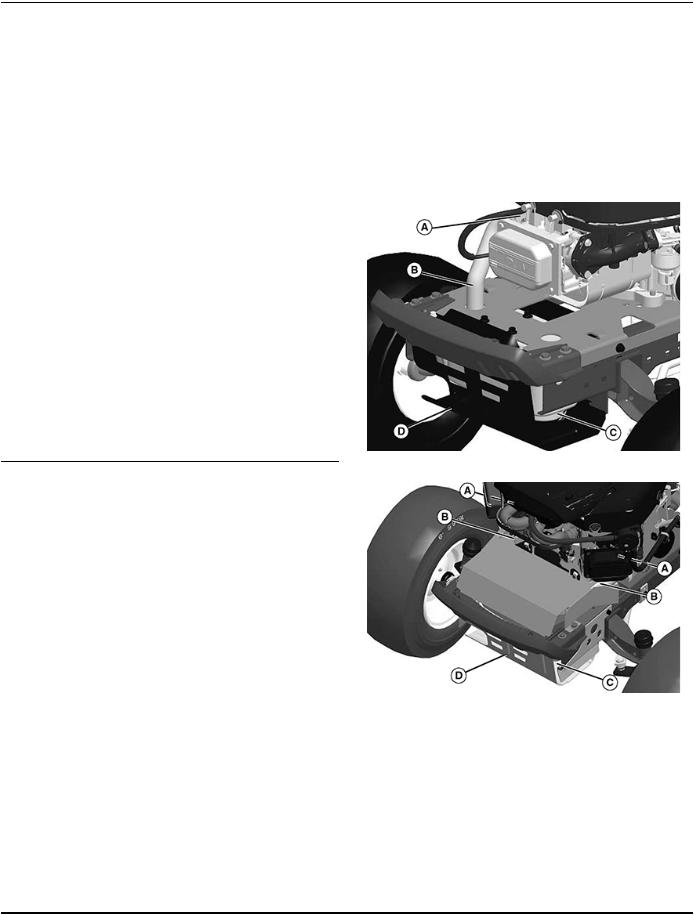
Machine Cleanout
•Always maintain the correct tire pressure. Do not inflate the tires above the recommended pressure. Never weld or heat a wheel and tire assembly. The heat can cause an increase in air pressure resulting in a tire explosion. Welding can structurally weaken or deform the wheel.
•When inflating tires, use a clip-on chuck and extension hose long enough to allow you to stand to one side and NOT in front of or over the tire assembly.
•Check tires for low pressure, cuts, bubbles, damaged rims or missing lug bolts and nuts.
Checking Wheel Hardware
•A serious accident could occur causing serious injury if wheel hardware is not tight.
•Check wheel hardware tightness often during the first 100 hours of operation.
•Wheel hardware must be tightened to specified torque using the proper procedure anytime it is loosened.
Handling Waste Product and Chemicals
Waste products, such as, used oil, fuel, coolant, brake fluid, and batteries, can harm the environment and people:
•Do not use beverage containers for waste fluids - someone may drink from them.
•See your local Recycling Center or authorized dealer to learn how to recycle or get rid of waste products.
•A Material Safety Data Sheet (MSDS) provides specific details on chemical products: physical and health hazards, safety procedures, and emergency response techniques. The seller of the chemical products used with your machine is responsible for providing the MSDS for that product.
Machine Cleanout
Prevent Fires
•Besides routine maintenance, one of the best ways to keep your John Deere equipment running efficiently and to reduce fire risk is to regularly remove debris buildup from the machine.
•Please review these recommendations with all operators. See your John Deere dealer with questions.
•Always follow all safety procedures posted on the machine and in this operator manual. Before carrying out any inspection or cleaning, always shut off engine, set parking brake and remove ignition key.
•After operating, allow machine to cool in an open area before cleaning or storing. Do not park machine near flammable materials such as wood, cloth or chemicals.
•Empty any grasscatcher bags or containers completely before storing.
•Frequency of these inspections and cleaning will vary depending on a number of factors including operating conditions, machine configuration, operating speeds and weather conditions particularly dry, hot and windy conditions. When you are operating in these conditions, inspect and clean these areas frequently throughout the day.
•Wind direction, terrain type and moisture content of surrounding vegetation can effect where and how much debris accumulates.
•Debris can accumulate anywhere on the machine, especially on horizontal surfaces.
•Keeping engine area clean will provide the greatest impact on fire prevention. Other areas requiring regular inspection and cleaning include behind wheel rims, wire harness, hose/line routings, mowing attachments, etc. Compressed air, leaf blowers or high pressured water can assist keeping these areas clean.
•Excess lubrication or fuel/oil leaks or spills on the machine can also serve as collection sites for debris. Prompt machine repair and oil/fuel
cleanup will minimize the potential for debris collection and reduced cooling throughout machine life.
•Bearing failures or overheating can result in a fire. To reduce this risk, always follow the instructions in the machine operator’s manual regarding lubrication intervals and locations. Washing the machine while warm may also reduce bearing life and increase potential for premature bearing failure.
•Always shut off fuel when storing or transporting machine, if the machine has a fuel shutoff.
Cleanout Areas
Primary areas that must be inspected and cleaned on the machine include (See Safety Label Section):
GXAL41967—UN—04MAR13
Single cylinder shown
GXAL41968—UN—04MAR13
Twin cylinder shown
1.Exhaust manifold (A), muffler pipe (B), muffler (C) and muffler shield
(D).
16
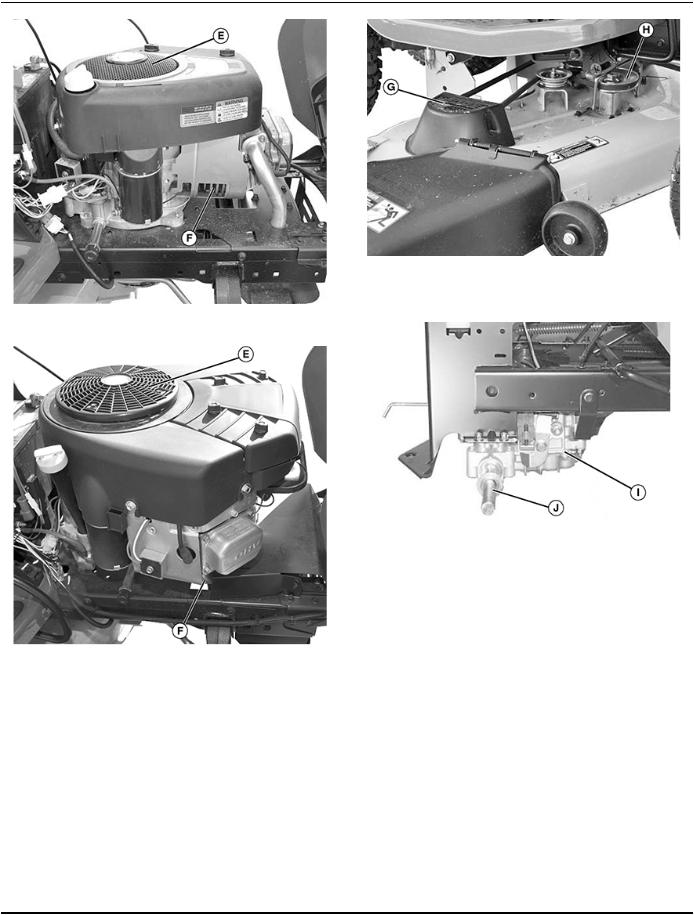
Machine Cleanout
GXAL41971—UN—04MAR13
3. Top of mower deck, under shields (G), including spindle (H) and belt
areas.
GXAL41969—UN—04MAR13
Single cylinder shown
GXAL41972—UN—04MAR13
Shown with wheel removed
4. On or near transmission (I) and driveline (J).
GXAL41970—UN—04MAR13
Twin cylinder shown
2.Engine intake screens (E), cooling fins (F), and oil cooler (if equipped).
17
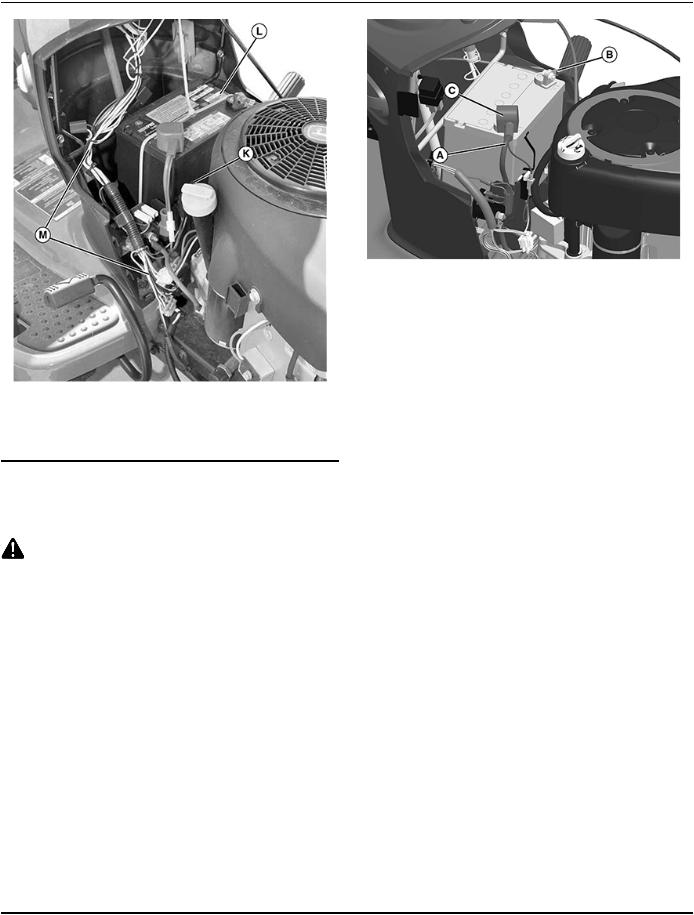
Assembly
GXAL41973—UN—04MAR13
5.Under left side panel near fuse block (K), and all wiring, including the battery (L) and related wiring harnesses (M).
GXAL41974—UN—04MAR13
4.Connect positive (+) battery cable (A) to battery.
5.Connect negative (–) battery cable (B).
6.Apply general purpose grease or silicone spray to terminal to help prevent corrosion.
7.Slide red cover (C) over positive battery cable.
Check Tire Pressure
Check tire pressure. (See Checking Tire Pressure in the SERVICE MISCELLANEOUS section.)
Assembly
Charge and Connect Battery
CAUTION: The battery produces a flammable and explosive gas. The battery may explode:
•Do not smoke or have open flame near battery.
•Wear eye protection and gloves.
•Never check battery charge by placing a metal object across the posts. Use a voltmeter or hydrometer.
•Do not jump start or charge a frozen battery. Warm battery to 16°C (60°F).
1.Remove and discard the tie strap from the positive (+) battery terminal.
2.Remove and discard the black protective cap from the negative (–) battery terminal.
3.Charge the battery.
Specification
Battery Full Charge — Voltage . . . . . . . . . . . . . . . . . . . . . . . . . . . . . . . . . . . . 12.6 volts
Adjust Mower Deck Level
Adjust mower deck level. (See Adjusting Mower Deck Level in the OPERATING section.)
Check Engine Oil Level
Check engine oil level. (See Checking Engine Oil Level in the SERVICE ENGINE section.)
Check Machine Safety System
Perform safety system check to make sure the electronic safety interlock circuit is functioning properly. Perform all tests. (See Testing Safety System in the OPERATING section.)
Break In Electric Engagement Clutch (If
Equipped)
1. Start engine and move machine to flat level surface.
18
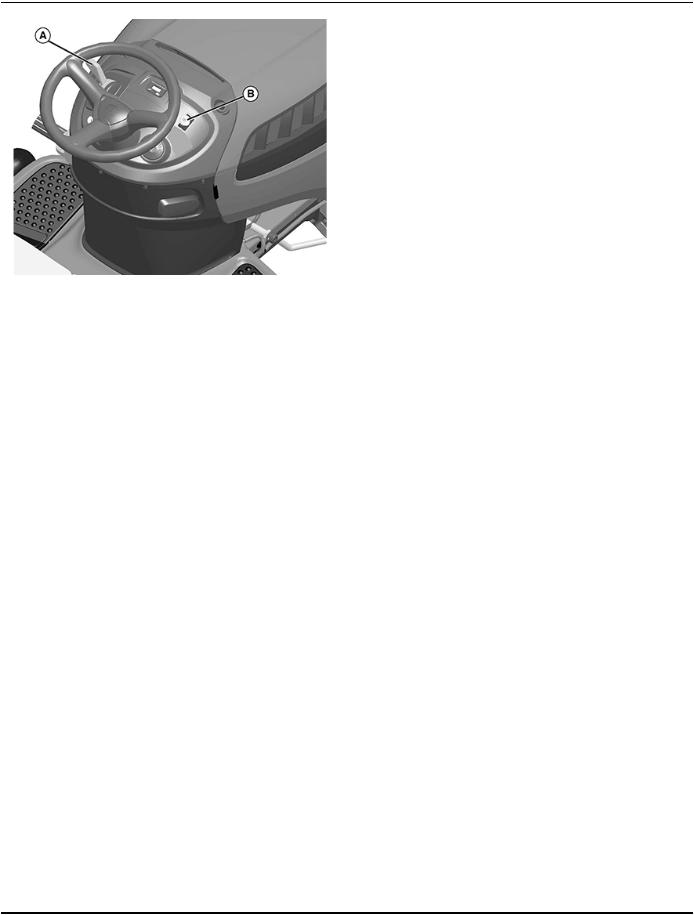
Assembly
GXAL41975—UN—04MAR13
2.Push throttle lever (A) up to full throttle position.
3.Engage attachment engagement switch (B) and allow mower to run for 10 seconds.
4.Disengage attachment engagement switch and wait 10 seconds.
5.Repeat steps 3 and 4 for 12-15 cycles.
NOTE: Clutch is now properly burnished.
19

Operating Controls
Operating Controls
Operator Station Controls (D105)
PY19028—UN—07AUG13
A — Brake pedal |
G — Attachment Engagement Lever |
B — Park Brake Lock Lever |
H — Motion Pedal |
C — Throttle/Choke Lever |
I — Deflector Shield |
D — Reverse Implement Option (RIO) Switch |
J — Transmission Shift Lever |
E — Service Reminder/Hourmeter |
K — Fuel Level Window |
F — Key Switch |
L — Attachment Lift Lever |
20
